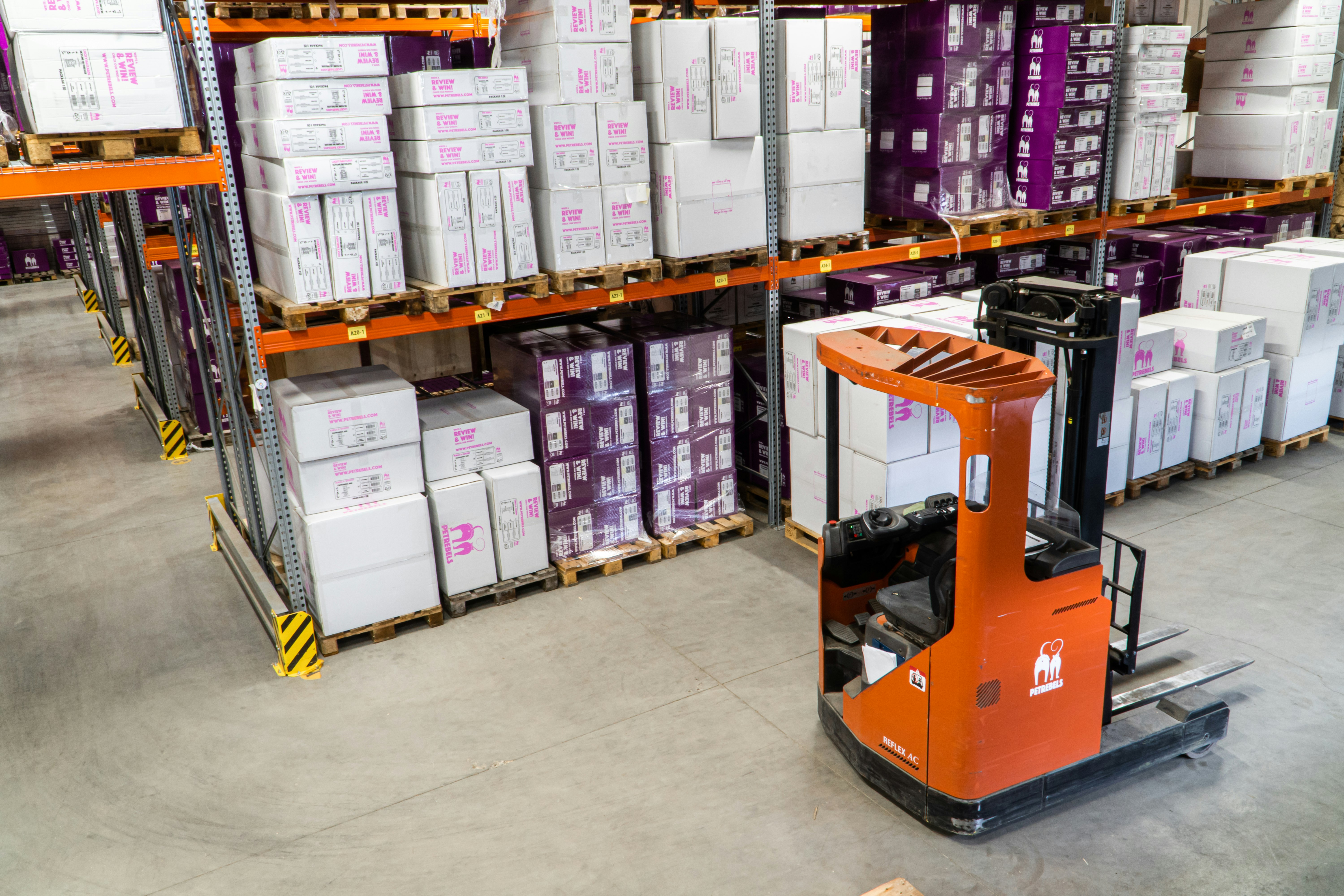Top News
Integration
In the past decade, Artificial Intelligence (AI) has come out as something that people use almost every day without even realizing it. Apart from powering a huge number of applications and other digital devices, this technology stands to benefit all industries including supply chain. In fact, many companies have already started benefiting from investing in AI. A report by State of Artificial Intelligence for Enterprises shows that supply chain is one of those areas which will significantly benefit from AI. On the other hand, PwC states that AI could inject up to $15.7 trillion to the global economy by 2030.
-
Go With The Flow: Streamlining Your Supply Chain Flow with AI
Monday, 08 October 2018
-
What’s Cloud Got To Do With It?
Wednesday, 05 September 2018
-
We were the machines
Tuesday, 12 June 2018
-
Is Blockchain the Answer… to Everything Supply Chain?
Monday, 07 May 2018
Retail
The global supply chain for food and agricultural products has become incredibly complex. As ingredients and products are sourced from all over the world, it can be difficult to track where something originated or how it moved through multiple stages of processing and distribution. This lack of transparency and traceability is a major challenge across the food industry. However, an emerging technology - blockchain - could transform traceability and trust in global food systems.
-
How Fashion can Tackle Growing Demands of a Stable and Agile Supply Chain
Monday, 18 September 2023
-
Circular Economy Needs To Factor In Clean Shipping
Monday, 15 May 2023
-
In Order to free up Shelf Space, Retailers are offering Black Friday Deals Today
Monday, 07 November 2022
-
Baby Formula is Latest Casualty of Supply Chain Crisis
Monday, 16 May 2022
Technology
Wearable technology has become increasingly popular in various industries over the years, and the warehouse sector is no exception. As this technology continues to make its way into the warehouse industry, warehouse workers are now leveraging technology such as wearables and augmented reality to streamline workflows and improve overall efficiency. These devices provide workers with hands-free access to vital information and improve communication on the warehouse floor.
-
The Dark Side of RFID: Employee Surveillance and Privacy Invasion
Monday, 30 October 2023
-
The Rise of Augmented Reality in Warehouse Operations
Monday, 23 October 2023
-
Cloud Computing Solutions for Supply Chain Efficiency
Monday, 11 September 2023
-
Harnessing Predictive Analytics for Demand Forecasting in Supply Chains
Monday, 04 September 2023
New Study Reveals Shocking Growth in Cognitive Supply Chain Market
A recent study conducted by Future Market Insights, Inc. predicts a staggering 15.6% surge in the cognitive supply chain market, reaching a whopping US$ 40.4 billion by 2034. This groundbreaking research highlights the increasing demand for advanced technology in supply chain management, with a focus on cognitive solutions that utilize artificial intelligence and machine learning. The study also delves into the potential impact of this growth on various industries and the global economy as a whole.
While this study may seem promising, it's important to question the validity of these predictions. Can we really trust a market research company to accurately predict the future of such a complex and ever-changing industry? And what about the potential drawbacks of relying too heavily on technology in supply chain management? As a fifth grader, I'm not convinced that this study is the end-all-be-all answer to the future of the cognitive supply chain market.
Want to Boost Profits? Check Out These 3 Supply Chain Cost-Cutting Tactics
In today's competitive business landscape, companies are constantly looking for ways to increase profits and decrease costs. According to Forbes, supply chain leaders are under pressure to achieve both of these goals while also scaling up production. This can be a daunting task, especially when faced with challenges such as geopolitical uncertainty and fluctuating raw material prices. However, there are a few strategies that can help reduce supply chain costs and improve efficiency. One of these is implementing engineering changes automation, which can significantly improve cycle times and reduce costs.
Opinions expressed by Forbes contributors are their own. As a co-founder of a successful manufacturing company, I have seen firsthand the benefits of implementing cost-cutting strategies in supply chain management. However, it is important to carefully consider the potential risks and challenges that may arise when making changes to the supply chain. It is crucial to have a well-rounded and diversified approach to cost reduction, rather than relying on one single tactic. With careful planning and implementation, these strategies can help businesses maximize profits and stay ahead in the competitive market.
Exiger Named Strategic Technology Partner for U.S. Government
The U.S. Partnership for Assured Electronics has chosen Exiger as its strategic technology partner to promote access to resilient and trusted electronics supply chains for the U.S. government. This partnership aims to ensure the security and reliability of electronic components used in critical government systems and infrastructure. With Exiger's advanced technology and expertise, the U.S. government can have confidence in the integrity of its electronics supply chain.
While this partnership may seem promising, it is important to remember that the U.S. government has faced numerous security breaches and supply chain vulnerabilities in the past. It remains to be seen if Exiger's technology can truly provide the level of trust and resilience needed for critical government systems. Only time will tell if this partnership will truly be effective in safeguarding the U.S. electronics supply chain.
Digital Supply Chain Market is Set to Reach $12.1 Billion by 2032
The digital supply chain market is rapidly expanding, driven by the latest technology and digital transformation solutions. According to DataHorizzon Research, this market was valued at $4.3 billion in 2022 and is expected to reach $12.1 billion by 2032 with a growth rate of 10.9%. This market is a game-changer for businesses looking to optimize their supply chain operations and gain a competitive edge. By integrating cutting-edge technologies such as the IoT, AI, data analysis, big data, and cloud computing, the digital supply chain streamlines and improves supply chain operations. This is a key component of Logistics 4.0, also known as smart logistics, which includes predictive and prescriptive analytics and process integration in the logistics industry.
While the digital supply chain market may seem like a promising solution for businesses, it is important to consider the potential drawbacks. With the heavy reliance on technology, there is a risk of system failures and data breaches, which could have significant consequences for companies. Additionally, the cost of implementing and maintaining these advanced technologies may be a barrier for smaller businesses. It is important for businesses to carefully weigh the benefits and risks before fully embracing the digital supply chain trend.
How to Utilize Digital Twins in Supply Chain Management
Digital twins have emerged as an effective strategy for overcoming disruptions and building resilience in supply chains. They can deliver data-driven insights and integrated planning capabilities that improve operations and keep business flowing smoothly.
Here’s how digital twins can improve supply chain management and how managers can implement them.
What Are Digital Twins?
Digital twins are a precise, high-level representation of a physical object, system or process. These virtual replicas benefit from a wealth of real-time data to generate models that mirror the characteristics and behaviors of their physical counterparts. Digital twins are utilized in a wide range of industries and applications.
In supply chain management, digital twin models utilize data — sales orders, demand and supply figures, weather conditions, pending approvals, warehousing capacity and more. This information comes from several sources, including:
- Internet of Things (IoT) devices: special sensors and trackers
- Operations databases: sales platforms and transaction information
- Logistics and transportation databases: inventory management, delivery tracking and route optimization information
- Supplier or vendor information: CRM data, order information, invoices and bills
- User experiences: online reviews, satisfaction surveys and customer service tickets
- Competitive analysis: competitor websites
Digital twins technology allows supply chain companies to actively monitor elements and dynamics within a virtual system to make data-driven decisions about the real-life supply chain. For example, DHL uses digital twins to track Tetra Pak packages in real-time at its Singapore warehouse.
Are Digital Twins the Same as Simulation Models?
While digital twins and simulation models share some similarities, they serve distinct purposes. The primary difference is that simulations use set parameters to analyze system performance before implementation in real life. In contrast, digital twins use real-time data to observe operations as they occur.
In this way, simulation models answer the question “What could happen if …” while digital twin models answer “What is happening?”
How Digital Twins Improve Supply Chain Management
The global supply chain management market is growing fast, with an estimated CAGR of 10.9% over the next nine years. The sheer volume of data and documentation to process is massive since it’s a customer-centric industry with complex operations across geographical borders. This presents challenges for supply chain managers, such as:
- How to make accurate decisions and maintain flexibility in the live market
- How to monitor manufacturing and transporting conditions to minimize disruptions
- How to track performance and detect risk factors on the go
Digital twins can help address these challenges by providing an analytic view of the intricate data points impacting these events. Specifically, they can help supply chain managers:
Forecast Problems
Digital twins technology provides an end-to-end view of processes across the supply chain, allowing managers to identify potential bottlenecks and inefficiencies. Since supply chains are still feeling the effects of disruptions from the pandemic, digital twins are an invaluable tool for assessing risk and developing tailored response plans.
Test Scenarios
Supply chain management stakeholders can use digital twins to test different scenarios without affecting the day-to-day operations of the real-world supply chain. For example, they can check for potential issues related to health pandemics, geopolitical conflicts and other black swan events to understand their potential disruptive impact. Armed with these insights, managers can plan strategic responses accurately and effectively.
Optimize Logistics
Implementing a digital twin supply chain allows for advanced modeling of the logistics process to pinpoint areas where disruptions and shortages mainly occur. It also provides an overview of real-world supply and demand dynamics, allowing logistics teams to model optimal deliveries based on actual data rather than relying on guesses and gut feelings.
Avoid Stockouts and Overstocking
Companies can generate digital inventory replicas using digital twin technology to monitor stock levels and conditions in real time. This benefit is significant in retail supply chain management, where e-commerce firms must often optimize inventory management with demand/supply forecasting to avoid overstocking or stockouts.
Support Sustainability Efforts
Sustainability monitoring is another way digital twins improve supply chains. Businesses can utilize sensors and tracking technologies to highlight where the bulk of their carbon emissions stem from and measure impact in a digital environment. This helps them make informed decisions regarding their sustainability initiatives.
Implementing Digital Twins
Implementing a digital supply chain twin requires a collaborative approach among all stakeholders. The main steps involved in the process include:
1. Mapping the Real-Life Supply Chain
This step is all about comprehensively mapping out the supply chain assets and operations to ensure a replica in the digital environment.
2. Determining the Data Sources
Decide where to pull real-time data to feed into the digital supply chain twin. These information sources must be relevant and directly impact physical supply chain operations.
3. Building the IT Architecture
A robust IT architecture is essential for a digital twin to mirror its real-life counterpart effectively. At the very least, it should be able to connect to multiple data sources and run different accurate simulations based on both real and virtual data.
4. Building the Digital Twin
Supply chain management is ever-evolving, so it’s vital to model the digital twin to handle long-term operations and variables. The model should be a precise representation of the real-life supply chain.
5. Simulating and Analyzing the Model
Run various simulations on the digital twin model using real-time data and analyze the results to gain better insights into optimizing the supply chain.
Digital Twins Can Transform the Supply Chain
Digital twins are completely transforming how supply chains function. These virtual models provide high-level visibility and low-risk testing capacity, allowing teams to minimize disruptions and maintain productivity even during times of uncertainty.
Zac Amos is the Features Editor at ReHack and a contributor at publications like DZone, Open Data Science, and IoT For All. You will find him covering supply chain and logistics tech, the IoT, and cybersecurity. For more of his work, follow him on Twitter or LinkedIn.
Cannabis Supply Chain Challenges in the USA: Navigating Complexities in a Rapidly Growing Industry
As more states in the USA legalize the recreational use of cannabis, the cannabis industry has grown in a rapid pace never anticipated by anyone. With this growth, however, comes various unique challenges for the cannabis supply chain. From cultivation to distribution and sales, each stage of the supply chain presents its own set of complexities that need to be overcome. This article sheds light on the intricacies of the cannabis supply chain and explores the obstacles faced by growers, distributors, and retailers within the industry. Examining regulatory compliance, quality control, transportation logistics, and marketing strategies the article article will provide a thorough understanding of the unique issues the cannabis industry faces in the ever-evolving landscape of legalization.
The Intricacies of the Cannabis Supply Chain:
The supply chain of the cannabis industry encompasses various stages, from cultivation and harvesting to processing, packaging, distribution, and sales. Each stage comes with its own challenges that must be addressed to ensure a smooth flow of products from producers to end consumers. For instance, the key challenge in the initial stage is sourcing raw materials or ingredients required for production. Producers need to establish reliable supply chains and find trusted suppliers who can consistently deliver high-quality inputs.
Another challenge is efficiently manufacturing cannabis products. This involves ensuring the production process is streamlined, optimizing resource utilization, and maintaining quality control standards. There are also technical difficulties, such as developing new manufacturing techniques or adopting advanced machinery, which one has to contend with in this phase.
Once the products are manufactured, the focus shifts to logistics and distribution. This stage is critical as it involves managing transportation, warehousing, and inventory to ensure the products reach their intended destinations promptly. Due to these difficulties, it requires collaboration with logistics providers, choosing the right mode of transport, and effective inventory management to prevent stockouts or overstocking.
Marketing and promotion also play a crucial role in the smooth flow of products. With the importance of marketing, companies must create effective advertising campaigns. They should also establish distribution channels, and engage with customers through various communication channels. Branding, packaging, and pricing strategies need to be carefully planned to attract consumers and differentiate the product from competitors.
Lastly, customer satisfaction and after-sales service are essential for a seamless product flow. Companies should always provide prompt and efficient customer support, handle product returns or replacements, and continually assess customer feedback to make improvements. Building strong relationships with consumers is vital for repeat purchases and word-of-mouth marketing.
In conclusion, each stage of the product flow process comes with its own challenges that must be overcome to ensure a smooth journey from producers to end consumers. However, addressing each of these challenges effectively allows companies to optimize their operations and deliver a seamless experience to customers.
- Regulatory Compliance
Regulatory issues remains a leading challenge in the cannabis supply chain. Remaining compliant with the complex and ever-changing regulations governing the industry in different states is often confusing, mainly considering varying rules and requirements in each state when it comes to licensing, testing, labeling, and packaging, leading to a patchwork of regulations that can be difficult to navigate. - Quality Control
Quality and consistency and ability to maintain them across the cannabis supply chain is crucial to building consumer trust and loyalty. From ensuring proper cultivation practices to implementing rigorous testing and quality control measures during processing and packaging, companies must strive to deliver products that meet the highest standards. - Transportation Logistics
After effective quality control, the next thing any company would want to look into is transportation of the cannabis products. This aspect presents unique challenges due to the nature of these products as controlled substances. Limited capacity, stringent security requirements, and varying state regulations can make it difficult to effectively and efficiently move products from producers to retailers. Additionally, rising fuel costs and increased transportation expenses add to the overall complexity of the transportation logistics. - Marketing Strategies:
While some states have legalized recreational use of cannabis, it remains a heavily regulated industry, particularly when it comes to marketing and advertising. Cannabis companies must carefully navigate advertising restrictions, ensuring compliance while also effectively reaching their target market. Finding innovative and compliant marketing strategies is a constant challenge for industry stakeholders.
Conclusion
The cannabis supply chain in the USA faces a myriad of challenges as more states legalize recreational use. From regulatory compliance and quality control to transportation logistics and marketing strategies, each obstacle requires careful consideration and strategic planning. As the cannabis landscape continues to evolve, maintaining a thorough understanding of these challenges will be essential for industry players looking to thrive in this rapidly growing market.
Optimizing Supplier Relationship Management with E-Procurement Systems
The business landscape has become unbelievably competitive in the world today, regardless of the industry. With this increasing competition, establishing strong supplier relationships is crucial for organizations to achieve their strategic goals. Although there are various ways of establishing a strong supplier relationship, one of the best and most effective tools that can streamline this process is the use of e-procurement systems. These software solutions offer a range of features that enable businesses to maximize the benefits of their supplier relationships and drive operational efficiency.
E-procurement systems allow organizations to have better control and insight into their procurement activities by providing real-time visibility into spending. With such visibility, businesses can improve supplier negotiations since companies can analyze their spending patterns and identify areas for cost savings. Optimizing processes and reducing manual errors through, e-procurement systems allows organizations to ensure accuracy and efficiency in supplier relationship management.
E-procurement systems also facilitate increased transparency and collaboration with suppliers. These software solutions help businesses streamline communication channels and foster stronger relationships with their supply chain partners. Improved collaboration results in better supplier performance because both parties can align their objectives and work towards shared goals. Ultimately, this integration enhances the overall efficiency of the supply chain.
The leading benefit of e-procurement systems is that it automates procurement processes. Previously manual tasks, such as requesting goods and services, can now be done seamlessly with a few clicks. This automation not only saves time but also reduces costs associated with manual paperwork and errors. With the help of e-procurement systems that allow tasks to be automated, employees can focus on more strategic tasks, as their time is freed up from tedious administrative duties.
In addition to streamlining procurement processes, e-procurement systems also offer contract lifecycle management capabilities. Managing contracts is no longer a complex undertaking involving many documents, thanks to these software solutions. Businesses can easily create, track, and manage contracts, ensuring compliance and reducing risks. This feature provides organizations with greater control over their supplier relationships and minimizes the chances of contractual disputes or breaches.
E-procurement systems also enable organizations to track spending more effectively. The consolidation of procurement data in one central platform allows businesses to gain a comprehensive overview of their expenses. With such visibility, businesses can identify areas that they should focus on for cost savings, negotiate better pricing with suppliers, and make data-driven decisions. With improved spend management, organizations can optimize their budget allocation and maximize every dollar spent.
With all the above advantages, it is evident that embracing e-procurement systems is essential for future-proofing supply chains. In today's rapidly changing business environment, agility and adaptability are key to success. E-procurement serves as an anchor that will ensure that organizations can respond quickly to market demands and fluctuations. Therefore, by leveraging technology, businesses can create a flexible and resilient supply chain that is ready to face future challenges.
In conclusion, e-procurement systems play a pivotal role in optimizing supplier relationship management. These software solutions streamline procurement processes, enhance collaboration with suppliers, and provide real-time visibility into spending. Embracing e-procurement helps businesses achieve cost savings, drive operational efficiency, and future-proof their supply chains. With these powerful tools at their disposal, organizations can nurture strong supplier relationships and gain a competitive edge in the market.
Supply Chain Simulation Models for Risk Analysis
Supply chain simulation models have become essential tools for supply chain managers. These tools allow supply chain professionals to analyze and optimize their operations with more ease and freedom than ever. Thanks to these models, supply chain industry players now have access to dynamic details and insights which has allowed them to expand the design analysis and optimization capabilities for supply chain managers. Through the combination of analytical optimization and dynamic simulation methods, supply chain managers can effectively address complex supply chain problems and lay the foundation for advanced supply chain development.
To start with, the implementation of supply chain simulation models for risk analysis allows manufacturers to identify and assess potential threats to their global supply chains. Monte Carlo simulation, in particular, can help optimize manufacturing processes by assessing risks and enabling informed decision-making. As the supply chain systems continue becoming increasingly complex, supply chain simulation is becoming the preferred choice for gaining strategic insights.
Secondly, a supply chain simulation showcases the behavior of a logistics network over time. This enables supply chain managers to determine safety stock values, evaluate inventory policies, identify bottlenecks, and cost service levels. Additionally, with simulation, robustness of the supply chain can be tested much safely and what-if questions answered regarding new manufacturing facilities or transport policies. Simulation is especially valuable when the underlying system is too complex to be examined through mathematical-analytical methods due to time-dependent random and interacting effects within the system.
Supply chain simulation models also provide a platform for scenario-based risk assessment. These platforms allow users to input different scenarios like a natural disaster, a sudden surge in demand, or a supplier disruption, organizations can simulate the consequences and understand the potential risks they may face. This enables proactive risk mitigation strategies to be developed.
Through simulation, businesses can quantify the impact of risks on key performance indicators (KPIs) like delivery times, inventory levels, and production costs. This quantitative analysis helps organizations prioritize risks based on their potential financial and operational impact, allowing for more informed decision-making.
Simulation models can uncover vulnerabilities within the supply chain that may not be apparent through traditional risk assessments. For example, they can reveal dependencies on single-source suppliers or bottlenecks in distribution networks. Identifying these vulnerabilities is the first step in building a more resilient supply chain.
Once potential risks are identified and quantified, simulation models can be used to evaluate different risk mitigation strategies. Businesses can test various scenarios, such as increasing safety stock levels, diversifying suppliers, or altering production schedules, to determine the most effective and cost-efficient ways to manage risks.
Supply chain simulation models can be continuously updated with real-time data, allowing organizations to monitor their supply chain performance and adapt to changing conditions. This flexibility is crucial in an environment where risks can evolve rapidly.
To implement supply chain simulation models for risk analysis, using software like anyLogistix is highly recommended. With anyLogistix, supply chain managers can model their supply chains comprehensively and take advantage of both analytical optimization and dynamic simulation methods. With this combination, businesses have the necessary tools to solve the most complex supply chain problems effectively and drive supply chain development forward. This powerful combination equips professionals with the essential tools to effectively solve the most intricate supply chain problems and propel the advancement of supply chain development.
In conclusion, implementing supply chain simulation models for risk analysis is crucial in today's complex supply chain landscape. Using these models enables supply chain managers to gain valuable insights, optimize their operations, and make informed decisions. With the right software and tools, supply chain simulation becomes an indispensable asset in designing lean, agile, and robust supply chains.
How Self-Driving Trucks Could Disrupt Trucker Lifestyles And The Trucking Subculture
Autonomous trucks are revolutionizing the freight industry, with significant technological advancements and investments dedicated to their development. Some forecasters even predict that truck driving will be among the first major industries to be targeted by AI-driven automation. However, it is unlikely that robotic trucks will completely decimate the trucking profession in one sudden phase transition.
This innovation has created new opportunities for the trucking industry, with autonomous trucks being employed on specific routes and under certain conditions. As a result, the industry will continue to require an increased number of truck drivers, especially as freight volumes grow over time. While autonomous trucks may not eliminate the need for human drivers, they have the potential to address some of the challenges faced by the industry, such as recruiting and retaining drivers, particularly in long-haul trucking.
One aspect that may be impacted by the introduction of autonomous trucks is the trucker culture and lifestyle. Trucking is not just a job, but a subculture that has developed its own unique sense of identity, rituals, and camaraderie. The advent of self-driving trucks could disrupt these established norms and traditions.
Traditionally, truckers spend long hours on the road, navigating vast distances and coping with the solitude and isolation that comes with the job. They rely on their driving skills, expertise, and deep knowledge of the roadways to get the job done. The sense of independence and freedom that trucking offers has shaped the trucker lifestyle, which includes the iconic image of a trucker behind the wheel, exploring the open road.
With the introduction of autonomous trucks, the role of the truck driver is likely to change. While drivers may still be needed for certain aspects of the journey, such as navigating city streets or addressing unexpected situations, autonomous technology will handle the majority of the driving tasks. This shift may reduce the sense of control and agency that truckers have enjoyed for years, potentially impacting their sense of job satisfaction and fulfillment.
Moreover, the introduction of autonomous technology could alter the social dynamics within the trucking community. Truckers often form close-knit networks, sharing stories, advice, and support with their fellow drivers at truck stops or on CB radios. The sense of camaraderie and solidarity is a vital part of the trucker subculture. If autonomous trucks become more prevalent, the traditional trucker community may experience changes as face-to-face interactions are reduced, and the reliance on technology for communication increases.
Additionally, the potential reduction of job opportunities for truck drivers due to the adoption of autonomous trucks could create economic challenges for individuals and communities that heavily rely on the trucking industry. The trucker lifestyle and culture are deeply connected to economic factors, and any disruption in the availability of trucking jobs could have a significant impact on both individual truckers and the communities they support.
It is important to note that the impact on trucker culture and the trucking subculture will not be uniform or immediate. The transition to autonomous trucks will likely occur gradually, providing time for adaptations and adjustments to be made within the industry and among truckers themselves. Moreover, human truck drivers will still play a role in the operation and maintenance of autonomous trucks, ensuring that their expertise and experience remain valuable assets.
In conclusion, while autonomous trucks have the potential to disrupt the trucker lifestyle and trucking subculture, the impact will depend on the rate of adoption and the extent to which autonomous technology replaces human drivers. The introduction of self-driving trucks may alter aspects of trucker culture such as the sense of independence and the social dynamics within the trucking community. However, the full effects will only become clear as the industry continues to evolve, and truckers adapt to the changes brought about by technological[1][2]
Personal Shopper Drones and Last Mile Delivery
Personal shopper drones are an exciting development in the field of last-mile delivery. These drones have the potential to revolutionize the way goods are delivered to consumers, offering a fast and convenient solution to the challenges of final-mile logistics.
The concept of personal shopper drones involves the use of unmanned aerial vehicles (UAVs) to transport goods directly to customers' doorsteps. These drones are equipped with advanced navigation and automation technologies that allow them to safely navigate through urban areas and deliver packages with precision and efficiency.
One of the key advantages of personal shopper drones is their ability to bypass traditional delivery routes and traffic congestion. By taking to the skies, they can avoid the challenges of navigating crowded streets and deliver goods directly to consumers in a fraction of the time it would take for a traditional delivery vehicle. This not only improves delivery speed but also reduces the carbon footprint associated with last-mile transportation.
Personal shopper drones also offer a level of convenience that is unparalleled in traditional delivery methods. With drones, consumers can receive their goods at their doorstep without the need to be present or interact with delivery personnel. This is particularly beneficial for busy individuals who may not have the time to wait for deliveries or prefer contactless transactions.
However, there are several limitations that currently restrict the potential of personal shopper drones in last-mile delivery. One of the main challenges is regulatory compliance. The operation of drones is subject to strict regulations and airspace restrictions in many countries, making it difficult to fully exploit their capabilities for commercial deliveries.
Another limitation is the weight and payload capacity of drones. While advancements in technology have led to the development of drones with increased payload capacity, the ability to carry larger and heavier packages remains a challenge. This restricts the types of goods that can be delivered by drones and may limit their applicability to small and lightweight items.
Additionally, the range and flight time of personal shopper drones are currently limited. Most commercially available drones have a relatively short flight time and range, which may restrict their use to localized delivery operations. This means that drones may be more suitable for deliveries in densely populated urban areas rather than remote or rural locations. This is primarily due to the higher concentration of potential customers in urban areas compared to less populated rural areas. In densely populated urban areas, delivery routes for drones can be more optimized and efficient, as there are shorter distances between delivery points and a greater number of customers in closer proximity.
Moreover, urban areas often have better infrastructure in terms of communication networks and landing areas, which are crucial for safe and reliable drone deliveries. Drones depend on the availability of strong and stable internet connectivity to ensure accuracy in navigation and real-time tracking. Additionally, urban areas tend to have designated landing spots, such as rooftops or open spaces, where drones can safely land and deliver packages.
In contrast, remote or rural locations usually have longer distances between delivery points, making drone deliveries less time and energy-efficient. The lack of proper communication infrastructure and landing spots further complicates the operations in these areas. Additionally, remote locations might have challenging environmental conditions, such as strong winds or rough terrain, which can pose risks to the stability and safety of the drones.
It is important to note that while drones can be more convenient for urban deliveries, there are still several regulatory, safety, and privacy concerns that need to be addressed before widespread drone deliveries can take place. Nonetheless, the potential for drones in densely populated urban areas is promising and can revolutionize the delivery industry by providing faster and more accessible services.
Despite these limitations, there is great potential for personal shopper drones to transform last-mile delivery. As technology continues to advance and regulations evolve, we can expect to see further improvements in drone capabilities, including increased payload capacity, extended range, and improved flight time.
In conclusion, personal shopper drones have the potential to revolutionize last-mile delivery by offering fast, convenient, and eco-friendly solutions. While there are limitations that currently restrict their widespread adoption, advancements in technology and regulatory frameworks are likely to pave the way for a future where drones deliver directly to consumers' doorsteps. [1]
Crazy Warehousing Robots - A Look At Some Of The Wackiest And Most Innovative Robots Being Used In Warehouses Today
Over the years, robots have become an essential part of streamlining operations and increasing efficiency in different industries. While robots have been there for many decades, they have never been as advanced as they are today. Unlike traditional robots, modern robots go beyond the typical automated machines we are accustomed to seeing. They are being referred to as "crazy warehousing robots" for their wacky and innovative features that make them stand out in the industry.
One such example is a pair of robots that resemble goofy green footstools from the future. Their round eyes and satisfied grins are rendered with light-emitting diodes. This gives them a quirky and unique appearance. Introduced in November 2022, these robots can pick individual products from storage cubbies and place them into larger plastic bins. This advancement brings them closer to achieving human-like dexterity, which has long been a holy grail in the field of robotics.
These crazy warehousing robots also have the ability to navigate the warehouse environment. Around 12,000 Pegasus robots can be seen in a warehouse in Reading, Massachusetts, zipping around the centre of the room. They are the size of lawn-mower-scale models. They drop packages down holes in the floor that lead to the loading docks. Once they have completed this task, they return to a designated parking spot on the floor, ready for their next assignment.
What sets these robots apart is the incorporation of lidar sensors on their heads, resembling tiny hats. The lidar sensors allow the robots to scan nearby objects and people in 3D, ensuring safe and efficient navigation through the warehouse. While this is an important component, it is not the only thing that makes them fascinating. On top of this ability, these robots also have a touch of whimsy. They might surprise observers sometimes by playing chipper tunes, flashing lights, or morphing their eyes into heart shapes. These playful gestures add a human-like element to their otherwise mechanical nature.
The implications of these crazy warehousing robots go beyond mere entertainment value. They have the potential to bring about a significant shift in the balance between automation and human labor. These robots can augment human workers and remove bottlenecks in the automation of manual work by performing tasks that were previously considered too complex for robots, such as dexterously picking individual items. This breakthrough could revolutionize the way warehouses operate for the better, leading to increased productivity and efficiency. Introducing automated robot systems into warehouses could also change the way these facilities operate. Incorporating advanced robotics technology into warehouse operations can witness a significant boost in productivity and efficiency. With this, the tasks that were traditionally time-consuming and labor-intensive can be automated, resulting in streamlined operations and reduced human error.
Warehouses can optimize their inventory management, order fulfillment, and logistics processes with the help of automated robot systems. These robots can efficiently organize and track inventory, reducing the chances of misplaced or lost items. Furthermore, automating these tasks can help warehouses save time and resources, ultimately improving overall productivity.
Additionally, these robots possess the ability to precisely locate and move products within the warehouse, eliminating the need for manual picking and sorting. This automation results in faster order fulfillment and a more efficient distribution process. Moreover, the robots can adapt to changes in order volume or seasons, enabling warehouses to scale their operations accordingly and handle peak periods with ease.
Incorporating automated robot systems can also enhance workplace safety by minimizing the risks associated with heavy lifting and repetitive movements. This technology can alleviate the physical strain on warehouse employees and promote a safer working environment.
Ultimately, this breakthrough has the potential to revolutionize the warehouse industry by shifting from traditional labor-intensive methods to a highly advanced and efficient system. Increasing productivity, optimizing inventory management, and enhancing workplace safety enables warehouses to stay ahead in a competitive market and meet the growing demands of e-commerce and retail sectors.
Overall, these wacky and innovative robots showcased in the world of warehousing are pushing the boundaries of what was once considered feasible in the field of automation. Their unique features and capabilities not only make them stand out visually but also demonstrate the tremendous strides being made in robotics. As technology continues to advance, we can expect to see even more astonishing and quirky robots being deployed in warehouses, transforming the way goods are handled and creating a more.
How 3D Printing is Transforming Supply Chain Processes
More than ever, 3D printing, also known as additive manufacturing, has emerged as a disruptive technology with the potential to revolutionize supply chain processes across various industries. This technology, apart from different application areas in supply chain is able to alter other industries for the better. In the supply chain sector, this innovative technology improves manufacturing methods offering numerous advantages over traditional manufacturing techniques, particularly in terms of flexibility, speed, and cost-effectiveness.
First, the leading way in which 3D printing is transforming supply chain processes is by making them independent from consumer demand. Unlike in the traditional methods where companies needed to rely on forecasting consumer demand and manufacturing parts in large batches to achieve economies of scale, 3D printing enables companies to manufacture parts on-demand, eliminating the need for minimum order batches and reducing the risk of excess inventory. This not only leads to cost savings but also enables companies to respond quickly to changing market demands.
Secondly, 3D printing on the supply chain is capable of bringing production closer to the final point of use. 3D printing reduces the need for extensive transportation and storage of goods by enabling localized manufacturing. As a result, it, leads to shorter delivery times and lower logistics costs. Therefore, companies can also take advantage of this technology to create a more flexible approach by producing small customized batches. With quick turnaround time, businesses can then meet the specific needs of customers while minimizing waste.
3D printing can also transform various aspects of the supply chain, including warehousing and distribution. With the digitalization of warehouses, companies can store digital designs as opposed to physical inventory. This significantly reduces storage space requirements. This not only frees up valuable warehouse space but also enables companies to easily customize products and quickly adapt to changes in demand.
Furthermore, 3D printing has the ability to enhance business intelligence in the supply chain. It does so through integrating it into supply chain processes, which enables companies to gather real-time data on production, inventory, and customer preferences. This data can help optimize production schedules, improve inventory management, and gain valuable insights into customer behavior, ultimately leading to more informed decision-making.
Adopting 3D printing in supply chain processes can also promote sustainability and environmental responsibility. Unlike the traditional manufacturing methods that often result in significant waste due to the need for mass production and excess inventory, 3D printing only uses the necessary materials to create a specific product, minimizing waste and reducing the carbon footprint.
From now into the future, the transformational potential of 3D printing in supply chain processes will be vast. With the continued evolution of this technology, we may witness a convergence of design, production, and distribution into one seamless supply chain function, with greater customer involvement throughout the entire process. This level of integration and customization has the potential to revolutionize the way products are manufactured and delivered, opening up new opportunities for businesses to innovate and thrive in an increasingly competitive global market.
In conclusion, 3D printing is transforming supply chain processes by enabling companies to become more independent from consumer demand, bringing production closer to the point of use, and offering greater flexibility and customization. This disruptive technology has the potential to revolutionize various aspects of the supply chain, from logistics and warehousing to business intelligence and sustainability. As companies continue to embrace and integrate 3D printing into their supply chain strategies, we can expect to witness a paradigm shift in how products are manufactured and distributed, ultimately leading to more efficient, agile, and customer-centric supply chains.
Industry 4.0 is bringing about Supply Chain 4.0. Are you ready?
 Transacting business in the supply chain generally means communicating orders via EDI formatted files or some other equally rigid set of rules. The reasons are easy to understand; order times are critical and specifications for orders are complex so their formats need to adhere to formats that can be instantly read by computerized systems.
Transacting business in the supply chain generally means communicating orders via EDI formatted files or some other equally rigid set of rules. The reasons are easy to understand; order times are critical and specifications for orders are complex so their formats need to adhere to formats that can be instantly read by computerized systems.
EDI requirements may be rigid but they change frequently so there’s some reason to believe that there is in fact, flexibility within the order process. But getting the details wrong causes errors and costs money. How will this tight connection fare in the age of what’s called ‘Industry 4.0’ as new technologies are brought into the mix? Is it possible that the long-standing EDI format will be replaced by directly connected machines (IoT) that avoid the details of creating and processing orders? Or will the deeply embedded format keep business at a slower pace than might be possible if things changed?
Industry 4.0
Internet of Things (IoT) is impacting manufacturing, shipping, warehousing, delivery, and even customer support by adding smart devices to things that have traditionally been, well… dumb. Dumb in the sense that they don’t communicate or have any way to sense their surroundings. That’s changing rapidly as we approach the widely touted 50 billion IoT devices expected to populate the earth by 2020. Whether any particular company wants to move toward these automated pipelines is as moot as those who declared they were not abiding by Walmart’s demand to implement EDI years ago.
Manufacturing facilities around the globe are adding smarts to their machinery or replacing old machines with newer and smarter ones that can go beyond the basics of their intended functions. They are attached wirelessly directly to their company’s management and ERP systems and communicate their current status. They take instructions about manufacturing conditions to adjust their speed and can even sense variations in the materials they work with and adjust their actions to create products that meet required specifications.
The data passed between those machines and the systems that control them amount to magnitudes of data that never existed meaning that traditional manufacturing facilities that operated manually and on a completely analog basis are becoming digital factories. The data itself presents both issues and opportunities for every point along the supply chain because it’s now possible for the end customer to be aware of the status of the product they expect to purchase, and for the manufacturing machine to know how many units it needs to build to meet demand.
Flexibility stretched
Every participant in the supply chain is being armed with more data than they have ever encountered. Their first challenge is to collect and store it; in itself a mundane IT task of managing storage and connectivity. But what is done with that accumulated data as it passes along the chain is what will define the next generation manufacturer, transport company, retailer, and even the end customer. Those that devote the time and resources to understanding, then imagining how Supply Chain 4.0 will look.
Walmart - The NEW Mandate
 It’s been a while since Walmart first insisted that its suppliers moved to its digital order process. Back then the prospect of using EDI rather than fax or phone to place orders seemed like a technological hurdle. And in fact it was a significant hurdle that plenty of suppliers bucked against. But today Walmart’s tactics have become accepted and electronic order processing is no longer the pariah it once was. Now the retailer is making another mandate to its suppliers. But this time it’s not about what but where.
It’s been a while since Walmart first insisted that its suppliers moved to its digital order process. Back then the prospect of using EDI rather than fax or phone to place orders seemed like a technological hurdle. And in fact it was a significant hurdle that plenty of suppliers bucked against. But today Walmart’s tactics have become accepted and electronic order processing is no longer the pariah it once was. Now the retailer is making another mandate to its suppliers. But this time it’s not about what but where.
Amazon’s Web Services (AWS) has been the go-to supplier of cloud based software deployments and an overwhelming number of companies have put their online software there. It’s easy, reliable, and competitively priced. But now that Amazon is competing directly with Walmart for retail business Walmart doesn’t want the digital guts of its business hosted on a competitor’s site. That’s understandable, and in fact in 2014 the company moved its entire ecommerce presence to the cloud - and not Amazon’s cloud.
Our colleague Steven J. Vaughan-Nichols explains the move and strategy here.
So where’s the mandate?
It isn’t enough that Walmart hosts its own data away from AWS. The retailer doesn’t want its suppliers hosting its data and the transactions they process on its competitor’s cloud either. The most recent mandate instructs suppliers to move their systems off AWS. They’re apparently fine with alternate cloud vendors like Microsoft Azure who are not direct competitors, but Amazon is a no-no.
To be clear, the mandate (for now) is directed at tech providers. So product suppliers who host their own systems on AWS may not be affected. But the move may turn out to indirectly impact product suppliers if their EDI service providers host their applications and data on AWS.
The ripple effect
Amazon has done a great job of delivering cloud computing facilities that make it easy for companies to deploy their software services. In fact it may be the default choice for smaller EDI service providers because they can concentrate on developing their systems and delivering high quality customer support while leaving the heavy lifting of server farms and data centers to Amazon.
If your EDI provider has received a mandate letter from Walmart to shift its cloud hosting services you can bet they are scrambling to meet whatever deadlines are being required. Their revenue is reliant on delivering their customers’ transactions (your transactions) to and from Walmart and every other trading partner you deal with. And because of the depth and breadth of Walmart’s vendor base nearly every EDI service provider has connections to Walmart.
Be proactive
Don’t know if you will be affected? Ask your EDI service provider where their applications are hosted and how they are responding to Walmart’s mandate. Either your provider will need to change or you will need to change your provider if you want to keep your business relationship with Walmart.
Your EDI App
 Moving EDI data around the globe is old hat to most of the folks reading this ec-bp newsletter. Managing the connections and translations can get complex and picky when it comes to the details of the files and the changes that need to be incorporated into translators to make processes flow properly. For most EDI practitioners, their roles are fairly well defined and fit well with established concepts. But as mobile devices take over I think the line between what is EDI and what is associated with end user interaction is changing.
Moving EDI data around the globe is old hat to most of the folks reading this ec-bp newsletter. Managing the connections and translations can get complex and picky when it comes to the details of the files and the changes that need to be incorporated into translators to make processes flow properly. For most EDI practitioners, their roles are fairly well defined and fit well with established concepts. But as mobile devices take over I think the line between what is EDI and what is associated with end user interaction is changing.
The majority of enterprise workers carry some kind of smart phone or tablet with them. That means that folks have at least the capacity to access their data and applications if it's important to do so.
But fewer people that have mobile devices connect to their supply chain systems using these devices. It could be that they never found it necessary to do so, or that they don't want to be bothered with work issues while they are away. But I believe the issue has more to do with having the proper applications in place to easily and quickly connect to their systems. For most, I think the issue is the availability of the appropriate app.
But is there really a reason to extend access beyond the company firewall? If every transaction processes correctly, and all systems work as they should, there is little reason to access these systems. But the reality is that there are always issues to be managed.
As mobile apps become more commonplace, forward thinking EDI providers and the companies that use them are seeing the demand for these apps from their users. Even if the apps deliver low levels of functionality for status checking and minor management tasks, not having these extensions to their systems will eventually be seen as missing features.
Big Data from EDI Can Make Predictions
 EDI is a significant source of big data. Of course that's no shock to anyone dealing with data storage or a VAN bill, but when you consider the volume of transactions and the number or companies involved, it would seem that there is a wealth of data in those transactions. The data now covers (depending on the trading partners) every aspect of the order process, from initial P.O. to final payment, with plenty of status updates along the way. So, what can be learned from all the data? It turns out that when looked at as an aggregate and put through the right analytical processes, there's plenty to be learned - and predicted.
EDI is a significant source of big data. Of course that's no shock to anyone dealing with data storage or a VAN bill, but when you consider the volume of transactions and the number or companies involved, it would seem that there is a wealth of data in those transactions. The data now covers (depending on the trading partners) every aspect of the order process, from initial P.O. to final payment, with plenty of status updates along the way. So, what can be learned from all the data? It turns out that when looked at as an aggregate and put through the right analytical processes, there's plenty to be learned - and predicted. EDI software/service providers/VANs that act as collecting points for EDI data are in a great position to help leverage this data because all the transactions they transfer between trading partners pass through their servers. At some point these transactions are stored on their servers, and some of the providers maintain those transactions for historical purposes. The newest trend that these providers are offering is to leverage those transactions by applying business intelligence techniques to them. What emerges from these advanced calculations takes on many forms, but in general they paint a picture of what has happened, and what is likely to happen in the future.
Popular Articles
- Most read
















































